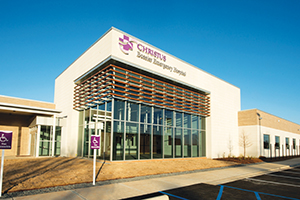By BETSY TAYLOR
When thinking big about the future of health care, several health care systems are opting to build small. They're opening micro-hospitals.
CHRISTUS Health and Ascension's St. Vincent-Indiana are among the ministry systems that have opened micro-hospitals, and they talked with Catholic Health World about the model. Experts say the model provides convenience for patients while allowing health systems to become more fleet-footed as they enter growing markets or adapt services to local needs and the competitive landscape.

CHRISTUS Shreveport-Bossier Health System opened CHRISTUS Bossier Emergency Hospital in Bossier City, La., in February. The 10,000-square-foot micro-hospital has an emergency department, full-service imaging and 11 short-stay inpatient beds.
According to Essential Insights, a publication of the health care supply chain company Cardinal Health, lower overhead costs in these facilities can provide a competitive advantage under value-based reimbursement insurance contracts.
The publication said the hospitals may charge the same rates as larger hospitals, particularly for emergency services.
Called neighborhood hospitals by some health care systems, micro-hospitals operate 24 hours a day, seven days a week. And, at 10,000 to 60,000 square-feet, they are markedly smaller than traditional community hospitals, and they have smaller staffs too. They're often in high-traffic areas in growing communities or in communities that can't support a large hospital. It's hard to get a good count on how many micro-hospitals are in the U.S., but there are dozens of them with more in the works.
Micro-hospitals' core services often include an emergency department, laboratory, imaging and pharmacy. The facilities have a small number of acute care beds. Other services vary depending on a community's needs. They often are built within about 20 miles of a full-service hospital and have protocols for the rapid transfer of patients with high-acuity medical needs or traumatic injuries beyond the scope of the micro-hospitals' resources, according to the Advisory Board Co., a consulting firm that works with health care organizations and educational institutions.
Tailored offerings
CHRISTUS Health runs two micro-hospitals and it may open others. They are Catholic, nonprofit facilities. CHRISTUS Trinity Mother Frances Health System opened CHRISTUS Mother Frances Hospital — South Tyler in February 2017. The 41,200-square-foot facility has eight inpatient beds. It has imaging and laboratory services and five outpatient surgical suites.
CHRISTUS Shreveport-Bossier Health System opened CHRISTUS Bossier Emergency Hospital in Bossier City, La., in February. The 10,000-square-foot hospital has an emergency department, full-service imaging and and 11 short-stay inpatient beds. It has a total staff of 55.

Wright
Stephen Wright, CHRISTUS Health's senior vice president group operations for Louisiana and Southeast Texas, said micro-hospitals are a cost-effective way to add services and access points as "close to patients as we possibly can."
Wright said in the Shreveport-Bossier market, the micro-hospital draws new business; other CHRISTUS facilities in the region haven't seen a drop in patient volume. "It's not redirecting business from existing locations to new locations," he said.
Ease of access
Dignity Health – St. Rose Dominican has partnered with The Woodlands, Texas-based Emerus to open four for-profit neighborhood hospitals in Las Vegas (see sidebar).
Ascension's St. Vincent – Indiana has opened four micro-hospitals, each known as a St. Vincent Neighborhood Hospital, in the Indianapolis suburbs of Avon, Noblesville, Plainfield and Castleton. St. Vincent partnered on the micro-hospitals with Houston-based for-profit Tandem Hospital Partners, which works with health care systems to build and operate the hospitals.
St. Vincent has four other micro-hospitals slated to open before the end of the year, another in Noblesville, one in the town of Brownsburg and two in Greenwood.
Jonathan S. Nalli, the chief executive of St. Vincent – Indiana, said the system is moving away from "big box" hospitals, tailoring facilities to make them easy to access. He said the neighborhood hospitals offer more convenience and make it easy for patients to get around within the facility.
St. Vincent is locating its neighborhood hospitals in areas where the system has patients, but lacks an inpatient or emergency services presence. "We're moving more health care to them. We've got to always be evolving and innovating how health care is delivered," he said.
Each St. Vincent neighborhood hospital has seven emergency room beds and eight inpatient beds. Nalli said each is staffed by board-certified emergency physicians and hospitalists, nurses and imaging, lab and pharmacy staff.
Nalli said St. Vincent's neighborhood hospitals are for-profit Catholic facilities that follow the Ethical and Religious Directives for Catholic Health Care Services.
Lessons learned
Nalli said Ascension will draw from learnings in the St. Vincent system as it considers additional neighborhood hospitals. Ascension broke ground this month on a neighborhood hospital in Austin, Texas.
Sarah Knisely-King, chief executive and chief nursing officer for St. Vincent Neighborhood Hospitals, said patient care protocols have been designed to shorten wait times, with a quick assessment and very basic registration within a minute of the patient's arrival. Patients arrive by ambulance, they walk in or can be referred for admission by a physician.
On average, a patient meets with a provider in about eight minutes, she said, adding that's about half as long as the national emergency room door-to-provider standard. Knisely-King said the neighborhood hospitals are set up for quick turnaround on in-house testing and imaging, as well, with about 15-minute results on many laboratory tests and radiology results in about 20 minutes.
She said St. Vincent's neighborhood hospitals also have communications technology that supports quick response times, like an integrated nurse call system tied into patient monitors. For instance, when a heart monitor detects a rhythm change in a patient with an arrhythmia, the monitor automatically sends the patient's nurse a text which appears on the electronic communications badge each nurse wears.
Knisely-King said the micro-hospitals have been designed to reduce barriers that hamper hospital efficiency. "This concept is something that has taken a lot of the good of every emergency room I've ever worked in before and pulled it together in a simple model," she said.
|
Dignity Health to replace Henderson, Nev., hospital campus with 'neighborhood hospital'
By around spring 2020, Dignity Health plans to build a neighborhood hospital on the Dignity Health – St. Rose Dominican Rose de Lima Campus in Henderson, Nev., where it will replace a 110-bed facility that dates from 1947.
Currently Dignity Health has three larger acute care hospitals — all called St. Rose Dominican — and four small neighborhood hospitals in Nevada. In addition to the Rose de Lima Campus and the 326-bed Siena Campus, both in Henderson, the system owns the 147-bed San Martín Campus in Las Vegas. Henderson is about 16 miles south of Las Vegas.
Last year, the health system opened its first four neighborhood hospitals — all in Las Vegas. One that opened in December in southwest Las Vegas is two stories and 38,500 square feet, with eight emergency room beds, eight inpatient beds, imaging and laboratory services and medical office space. The others are similar in size and scope.
Dignity Health has not yet said how many beds it will have at its new Rose de Lima neighborhood facility in Henderson. The hospital also will have an emergency department and Dignity Health administrative offices. The neighborhood hospital could be built in or adjacent to the existing community hospital. The refurbished campus may have behavioral health services, and added medical offices, but that decision has not been finalized, according to information from Dignity Health.
A rehabilitation facility currently located on the Rose de Lima Campus will move to the Siena Campus.
Dignity Health said there are multiple competing hospitals serving Henderson and its patient volumes have trended downward at the Rose de Lima Campus, but demand has increased at the San Martín and Siena Campuses.
— JULIE MINDA
|
Copyright © 2018 by the Catholic Health Association
of the United States
For reprint permission, contact Betty Crosby or call (314) 253-3490.